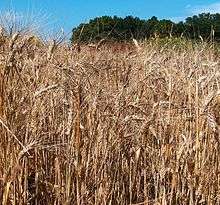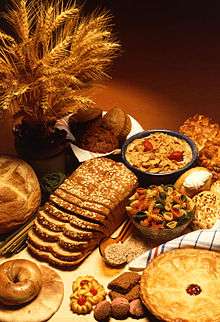Durum
Durum wheat[2] (/ˈdjʊərəm/), also called pasta wheat[3] or macaroni wheat (Triticum durum or Triticum turgidum subsp. durum),[4] is a tetraploid species of wheat.[5] It is the second most cultivated species of wheat after common wheat, although it represents only 5% to 8% of global wheat production.[6] It was developed by artificial selection of the domesticated emmer wheat strains formerly grown in Central Europe and the Near East around 7000 BC, which developed a naked, free-threshing form.[7] Like emmer, durum wheat is awned (with bristles). It is the predominant wheat that grows in the Middle East.
| Durum | |
|---|---|
 | |
| Durum wheat | |
| Scientific classification | |
| Kingdom: | Plantae |
| Clade: | Tracheophytes |
| Clade: | Angiosperms |
| Clade: | Monocots |
| Clade: | Commelinids |
| Order: | Poales |
| Family: | Poaceae |
| Genus: | Triticum |
| Species: | T. durum |
| Binomial name | |
| Triticum durum Desf. | |
| Synonyms[1] | |
|
List
| |
Durum in Latin means "hard", and the species is the hardest of all wheats. This refers to the resistance of the grain to milling, in particular of the starchy endosperm, implying dough made from its flour is weak or "soft". This makes durum favorable for semolina and pasta and less practical for flour, which requires more work than with hexaploid wheats like common bread wheats. Despite its high protein content, durum is not a strong wheat in the sense of giving strength to dough through the formation of a gluten network. Durum contains 27% extractable wet gluten, about 3% higher than in common wheat (T. aestivum L.).[8]
Genealogy
Durum wheat is a tetraploid wheat, having 4 sets of chromosomes for a total of 28, unlike hard red winter and hard red spring wheats, which are hexaploid (6 sets of chromosomes) for a total of 42 chromosomes each.[9]
Durum wheat originated through intergeneric hybridization and polyploidization involving two diploid (having 2 sets of chromosomes) grass species: T. urartu (2n=2x=14, AA genome) and a B-genome diploid related to Aegilops speltoides (2n=2x=14, SS genome)[10] and is thus an allotetraploid (having 4 sets of chromosomes, from unlike parents) species.
Uses
Commercially produced dry pasta, or pasta secca, is made almost exclusively from durum semolina.[11] Most home made fresh pastas (pasta fresca), such as orecchiette and tagliatelle, also use durum wheat or a combination of soft and hard wheats.
Husked but unground, or coarsely ground, it is used to produce the semolina in the couscous of North Africa and the Levant. It is also used for Levantine dishes such as tabbouleh, kashk, kibbeh, bitfun and the bulgur for pilafs. In North African cuisine and Levantine cuisine, it forms the basis of many soups, gruels, stuffings, puddings and pastries.[12] When ground as fine as flour, it is used for making bread. In the Middle East, it is used for flat round breads, and in Europe and elsewhere, it can be used for pizza or torte. Couscous is a Middle Eastern dish made from small, boiled balls of durum wheat.[13] The Israeli variant of couscous involves larger pearls of durum called ptitim in Hebrew.[14]
Durum flour and semolina are good for making pasta because they do not create doughs hard to shape, e.g. into sheets. Technically, the dough is relatively plastic, contrasting with the strong elastic doughs obtained from bread flours. Durum is rich in gluten but that is not readily available as the endosperm is hard to break to release that gluten. Durum wheat is thus less used in breadmaking. Its protein content is almost as high as that of hard spring or winter wheat and so is its gluten content, necessary for bread to rise. Although 100 percent durum wheat breads do exist (such as pagnotte di Enna or "rimacinato" bread from Sicily, as well as Altamura bread from Apulia and Matera bread from Basilicata) in most instances bread doughs contain only a portion of durum wheat and are supplemented substantially with commercial white flours, often those higher in gluten necessary to offset the poor contribution of durum flour to the gluten network. Pure durum wheat breads are often dense, containing little air bubbles, with relatively little elastic structure (continuum). The uncooked dough splits easily and is easier to shape, as for instance to make pies or pastas.
The use of wheat to produce pasta was described as early as the 10th century by Ibn Wahshīya of Cairo. The North Africans called the product itrīya, from which Italian sources derived the term tria (or aletría in the case of Spanish sources) during the 15th century.[12]
Production
Most of the durum grown today is amber durum, the grains of which are amber-colored and larger than those of other types of wheat. Durum has a yellow endosperm, which gives pasta its color. When durum is milled, the endosperm is ground into a granular product called semolina. Semolina made from durum is used for premium pastas and breads. There is also a red durum, used mostly for livestock feed.
The cultivation of durum generates greater yield than other wheats in areas of low precipitation (3–5 dm). Good yields can be obtained by irrigation, but this is rarely done. In the first half of the 20th century, the crop was widely grown in Russia.[15] Durum is one of the most important food crops in West Asia. Although the variety of the wheat there is diverse, it is not extensively grown there, and thus must be imported.[16] West amber durum produced in Canada is used mostly as semolina/pasta, but some is also exported to Italy for bread production.[17]
In the Middle East and North Africa, local bread-making accounts for half the consumption of durum. Some flour is even imported. On the other hand, many countries in Europe produce durum in commercially significant quantities.[18]
In India durum accounts for roughly 5% of total wheat production in the country, and is used to make products such as rava and sooji. [19]
Production of wheat 2017/2018[20]
| Producer | Production (1000 metric tonnes) |
|---|---|
| 151.6 | |
| 129.7 | |
| 98.5 | |
| 84.9 | |
| 47.3 | |
| 30.0 | |
| 26.9 | |
| 26.6 | |
| 21.5 | |
| 21.0 |
Processing and protein content
Durum wheat is subject to four processes: cleaning, tempering, milling and purifying. First, durum wheat is cleaned to remove foreign material and shrunken and broken kernels. Then it is tempered to a moisture content, toughening the seed coat for efficient separation of bran and endosperm. Durum milling is a complex procedure involving repetitive grinding and sieving. Proper purifying results in maximum semolina yield and the least amount of bran powder.[21]
To produce bread, durum wheat is ground into flour. The flour is mixed with water to produce dough. The quantities mixed vary, depending on the acidity of the mixture. The dough is mixed with yeast and lukewarm water, and then fermented for hours.
The quality of the bread produced depends on the viscoelastic properties of gluten, the protein content and protein composition.[8][18] Containing about 12% total protein in defatted flour compared to 11% in common wheat, durum wheat yields 27% extractable, wet gluten compared to 24% in common wheat.[8]
Health concerns
Because durum wheat contains gluten,[8] it is unsuitable for people with gluten-related disorders such as celiac disease, non-celiac gluten sensitivity and wheat allergy.[22]
References
- "The Plant List: A Working List of All Plant Species". Retrieved 28 August 2014.
- "Triticum durum". Natural Resources Conservation Service PLANTS Database. USDA. Retrieved 3 February 2016.
- "BSBI List 2007". Botanical Society of Britain and Ireland. Archived from the original (xls) on 2014-10-23. Retrieved 2014-10-17.
- "Triticum durum". Germplasm Resources Information Network (GRIN). Agricultural Research Service (ARS), United States Department of Agriculture (USDA). Retrieved 11 December 2017.
- "Wheat". Archived from the original on 2014-03-30.
- "Global durum wheat use trending upward". world-grain.com. Retrieved 21 March 2018.
- "Triticum (genus)". Biodiversity explorer. Archived from the original on 2008-10-10.
- Zilić S, Barać M, Pešić M, Dodig D, Ignjatović-Micić D (2011). "Characterization of proteins from grain of different bread and durum wheat genotypes". Int J Mol Sci. 12 (9): 5878–94. doi:10.3390/ijms12095878. PMC 3189758. PMID 22016634.
- Wishart 2004, p. 56, Wheat.
- Kubaláková, Marie; et al. (June 2005), "Chromosome Sorting in Tetraploid Wheat and Its Potential for Genome Analysis", Genetics, NIH, 170 (2): 823–9, doi:10.1534/genetics.104.039180, PMC 1450420, PMID 15802508.
- Sicignano, A.; Di Monaco, R.; Masi, P.; Cavella, S. (2015). "From raw material to dish: pasta quality step by step". Journal of the Science of Food and Agriculture. 95 (13): 2579–2587. doi:10.1002/jsfa.7176. PMID 25783568.
- Watson 2008, pp. 20–3.
- Shulman, Martha Rose (23 February 2009b). "Couscous: Just Don't Call It Pasta". The New York Times. Retrieved 11 December 2017.
- Abby Callard (22 March 2010). "Newly Obsessed With Israeli Couscous". Smithsonian Magazine Online. Retrieved 11 December 2017.
- Bushuk & Rasper 1994, p. 170.
- Brown et al. 1989, p. 95.
- Bushuk & Rasper 1994, p. 34.
- Matz 1999, pp. 23–5.
- "Indias durum production a poor cousin in wheat basket". Financial Express. Delhi. 31 October 2005.
- "World wheat production by country 2017/2018 | Statista". Statista. Retrieved 2018-07-30.
- Donnelly & Ponte 2000, p. 650.
- Tovoli F, Masi C, Guidetti E, Negrini G, Paterini P, Bolondi L (Mar 16, 2015). "Clinical and diagnostic aspects of gluten related disorders". World J Clin Cases. 3 (3): 275–84. doi:10.12998/wjcc.v3.i3.275. PMC 4360499. PMID 25789300.
Sources
- Brown, AHD; Marshall, DR; Frankel, OH; Williams, JT; International Board for Plant Genetic Resources, eds. (1989), The Use of Plant Genetic Resources, Cambridge, UK: Cambridge University Press, ISBN 0-521-34584-7
- Bushuk, W; Rasper, Vladimir F (Aug 1994), Wheat: Production, Properties and Quality, Springer, ISBN 978-0-7514-0181-3
- Donnelly, Brendan J; Ponte, Joseph G Jr (2000), "Pasta: raw materials & processing", in Kulp, Karel; Ponte, Joseph G Jr (eds.), Handbook of Cereal Science and Technology, Food science & technology — Marcel Dekker, 99 (2nd, rev & exp ed.), New York: CRC Press, ISBN 978-0-8247-8294-8
- Matz, Samuel A (1999) [1972], Bakery technology and engineering (3rd ill ed.), Springer, ISBN 978-0-442-30855-1
- Watson, Andrew (October 2008) [1983], Agricultural innovation in the early Islamic world: The Diffusion of Crops and Farming Techniques, 700–1100, Studies in Islamic Civilization, Cambridge, UK: Cambridge University Press, ISBN 978-0-521-06883-3
- Wishart, David J (2004), Encyclopedia of the Great Plains, University of Nebraska Press
Further reading
- Cohen, Daniel (2006). Globalization and its enemies. MIT Press..
- Griggs, C Wilfred; Amitai-Preiss, Reuven; Morgan, David (2000). The Mongol Empire and Its Legacy. Brill Publishers..
- Taylor, Julie (2005). Muslims in Medieval Italy: The Colony at Lucera. Lexington Books.
External links
| Wikimedia Commons has media related to Triticum durum. |
